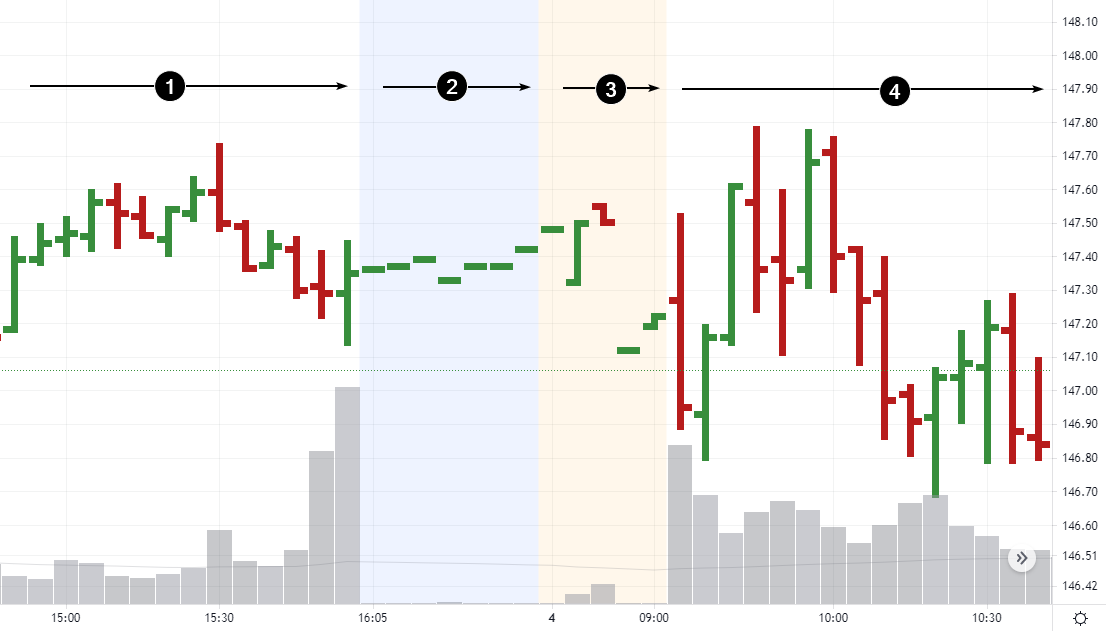Pre-market. Specific features of trading stocks on the American exchange
WHAT PRE-MARKET ON THE EXCHANGE IS IN SIMPLE WORDS
Let’s describe it using the picture below:
The chart reflects dynamics of trading AAPL stock, which is carried out on the NASDAQ. The pre-market concept is also true for the NYSE.
The numbers in the picture have the following meaning:
- Closing of the main trading session (the exchange is closed at 16:00).
- Post-market continues until 20:00 when it is possible to trade after the main session closing.
- The US pre-market opens at 4:00 in the morning and lasts until 9:30.
- Opening Bell rings at 9:30 and the main trading session opens.
SCHEDULE
The table below shows when the US pre-market opens (Eastern Daylight Time and Moscow Time).
| Eastern Time | Moscow Time | |
| Pre-market | 4:00 – 9:30 8:00 – 9:30 |
11:00 – 16:30 15:00 – 16:30 |
| Main session | 9:30 – 16:00 | 16:30 – 23:00 |
| Post-market | 16:00 – 20:00 | 23:00 – 3:00 |
Notes:
- The table shows the time of the summer period, when the difference in time between New York and Moscow is 7 hours. In winter, the difference is 8 hours. In any case, you should use the US time (Eastern Daylight Time).
- Pre-market opening time at 4:00 is valid only for some US stocks. For many stocks, the pre-market can open at 8:00 in the morning (local time) or can not be held at all.
WHY PRE-MARKET WAS INTRODUCED
First, the pre-market emerged due to a competition between stock exchanges. On May 20, 1991, the NYSE received approval of the US Securities and Exchange Commission for a limited trading outside normal working hours. It was done to provide customers with wider possibilities as it was done on Tokyo and London exchanges.
Bloomberg wrote: “The New York Stock Exchange faces global competition dangers since many investors and traders consider the NYSE to be boring and without any imagination”.
Second, technological development. Trading outside working hours was easier to implement since US stock trades moved to the electronic form. Thus, pre-market stock trading is carried out through Electronic Communication Networks (ECNs), which do not have physical location. In other words, buyers and sellers connect with each other through a digital network. NYSE Archipelago (ARCA) is one of such ECN. Others are: Instinet (INCA), Island (ISLD) and Bloomberg Trade Book (BTRD).
Third, the wish of investors who wanted to respond to news publications faster. Companies has a strategic approach to publication of important information, such as profit and loss reports. They do not like making announcements during regular trading sessions, because it can cause a strong reaction, which will corrupt the real value of their stocks.
According to Cris Concannon, executive Vice-President of the NASDAQ Transaction Services group: “Many companies inform about profit either before the market opening or after its closing. Internal stock value is constantly changing independent of whether the market is open or not, and people want to have access to the market immediately, when the internal value changes”.
Other events, which may cause interest in the pre-market, include court judgements, product presentations, changes in top management and others. If an influential analyst will decrease or increase a stock rating, it may also stimulate this stock trading during pre-market.
SPECIFIC FEATURES OF THE US PRE-MARKET
Look at the very first picture. As you can see from the volume and price dynamics, the pre-market trading nature is very different from what takes place during the main session.
We have already mentioned that the US pre-market trading is carried out through ECNs. Moreover, your broker can transmit you data only from one ECN, which makes it impossible to see the whole picture. It may even be that you will not be able to execute a trade with another investor if you have different incompatible ECNs.
There are also other specific features.
- Lower liquidity. Spreads (what a spread is) can be significantly wider than during the main session. As a consequence, pre-market prices are unstable and multiple gaps usually emerge in the chart. In fact, the pre-market can be rather risky due to a possible slippage.
- Limitations by order types. Many electronic trading systems nowadays accept only limit orders during pre-market and after closing.
- Limitations by order amounts. Brokers may not accept orders the amount of which exceeds USD 25,000 and impose other constraints, for example, on moving positions from the pre-market to the main session. Consult your broker.
- Competition with professional traders. Many traders that work outside working hours are professionals working for big organisations such as mutual investment funds, which can have access to a bigger volume of information than regular investors.
- Technical failures. You can face delays or failures in execution of your order during pre-market (actually, it can also happen during the main session), including orders of cancelling or changing your previous orders.
![]()
